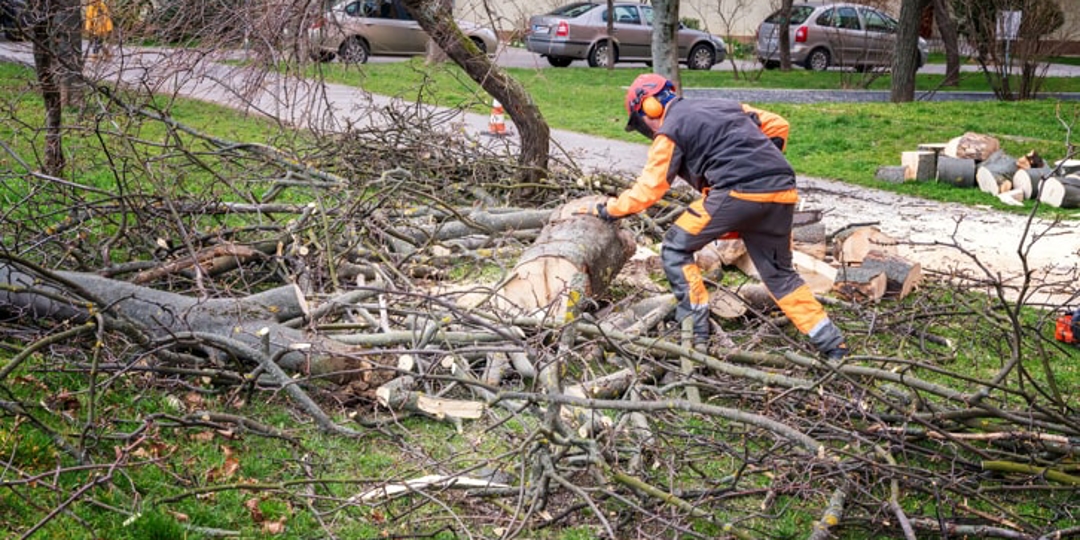One of the best ways to improve the value and safety of your property is by removing and properly disposing of hazardous trees. Any tree that is dead or damaged—with rotten wood, large dead limbs, significant leaning, or exposed roots—should be considered a potential risk and should be removed promptly.
These trees or limbs often present a danger of falling, which can lead to accidents or serious property damage. Removing trees affected by pests or disease is also essential to prevent the spread of infection to healthy trees nearby.
What Makes a Tree Hazardous?
A hazardous tree typically shows signs of structural defects, disease, decay, or root damage. Indicators may include:
- A thinning canopy
- Continuous leaf shedding
- Bare or drying branches
Such issues compromise a tree’s anchorage, making it more likely to fall during storms or high winds.
Rotten or dead limbs are especially dangerous, as they can fall and injure people or damage property. Similarly, a tree that leans significantly may be unstable and could topple over without warning. Structural weaknesses like trunk cavities, cracks, or splits can also increase the risk of failure.
Trees growing near buildings, highways, or utility lines should be evaluated. Their limbs or roots can interfere with infrastructure, create obstructions, or become fire and safety hazards.
Risks to Property and People
Falling trees or limbs can cause serious injuries to people and damage to vehicles, buildings, and other property. In some cases, these accidents can be fatal.
Structurally unsound trees may fall on buildings, resulting in costly repairs and potential harm to occupants. Trees falling on power lines can trigger fires, widespread outages, and other safety concerns.
Tree roots can also compromise the integrity of foundations and sidewalks. Identifying and removing such trees early helps avoid long-term damage. In storm-prone areas, downed trees can destroy landscaping and leave behind dangerous debris. Early, planned removal is the best way to prevent this.
Storms and Their Impact on Tree Stability
Storms and hurricanes are common in Houston and can severely damage trees, often requiring emergency removal. Branches weakened by disease or decay are especially prone to snapping during high winds. Hollow trunks may split, and trees with shallow or weakened roots are more likely to be uprooted.
Heavy rains can erode soil and weaken a tree's root system. Flooding accelerates root rot, further destabilizing the tree. Winter storms can bring ice accumulation that weighs down branches until they snap.
Lightning strikes are also a threat. Trees struck by lightning may split along their trunks or become structurally weakened, creating an entry point for pests and disease.
The Role of Professional Hazard Assessments
If you suspect a hazardous tree on your property, it’s important to consult a certified arborist. A professional can assess the tree’s condition and recommend safe removal options to protect your property and surroundings.
Certified arborists conduct thorough inspections to identify signs of structural instability, disease, or decay. Using reliable risk assessment tools, they determine which trees pose a high risk of failure and plan for their safe removal.
Tree removal professionals use specialized equipment and techniques to ensure minimal impact on nearby structures and landscapes. Reputable providers also carry insurance to protect against any accidental damage and always adhere to local regulations.
Safe Removal Methods for Hazardous Trees
Professional crews may use one of several safe and proven tree removal techniques, including:
- Controlled Felling – Directing the fall of a tree into a designated area using precise rigging techniques.
- Sectional Dismantling – Cutting the tree into smaller, manageable sections for safe and careful removal.
- Rigging and Crane-Assisted Removal – Used when space is limited or the tree is near structures.
Crews use proper PPE and take strict safety precautions at each step to protect both people and property.
Schedule a Hazard Evaluation with Monster Tree
If you're a resident of Houston, TX, in need of professional tree inspection or removal, Monster Tree Services is here to help.
We specialize in hazardous tree removal using advanced techniques to ensure safe, efficient results. Our certified arborists also offer services such as emergency tree removal, stump grinding, tree trimming, pest and disease treatment, and full-scale landscape care.
Contact Monster Tree Services today to schedule your hazard evaluation and take proactive steps to protect your property.

